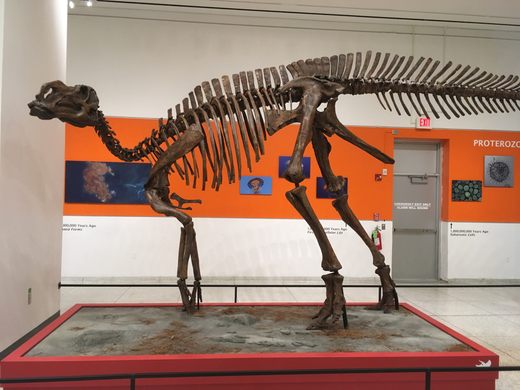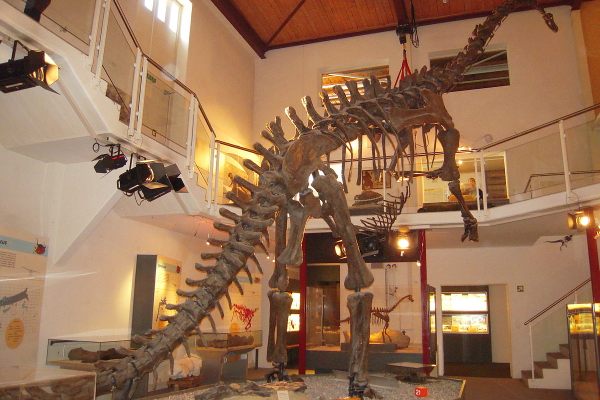Dryptosaurus Skeletal Mount
The way these carnivorous dinosaurs are posed is an homage to a classic work of paleoart.
Discovered in 1866 in a New Jersey marl pit, Dryptosaurus was the first partially-complete skeleton of a carnivorous theropod dinosaur in North America.
The paleontologist Edward Drinker Cope originally named the species Laelaps after a hunting dog from Greek mythology. But after it was discovered that the taxonomic name had previously been used for a species of beetle, Cope’s paleontological rival Othniel Marsh renamed the dinosaur Dryptosaurus (from the Greek for “tearing lizard”) in 1877.
Dryptosaurus is a distant and somewhat smaller relative of Tyrannosaurus rex. In the late Cretaceous when both species lived, North America was divided down the middle by an interior sea, which allowed Dryptosaurus to evolve without competition from its larger cousin.
Though Dryptosaurus has fallen into relative obscurity today, it was one of the most popular prehistoric animals in North America in the late 1800s, primarily due to a painting called “Leaping Laelaps” created by the artist Charles Knight. Knight’s work depicted two of these dinosaurs fighting as active, agile animals—a sharp contrast to other paleoart of the time which illustrated dinosaurs as sluggish, tail-dragging monsters.
In 2014, the New Jersey State Museum honored the theropod with a mount of two Dryptosaurus skeletons posed like the subjects of Knight’s painting. Since the original Dryptosaurus remains are incomplete—consisting of a partial jaw, hips, legs, claws and some vertebrae—many parts of the two skeletal reconstructions are estimates based on closely related tyrannosaurids such as Appalachiosaurus, whose fossils have been found in the southeastern United States.
Know Before You Go
The New Jersey State Museum is open Tuesday to Sunday from 9 a.m. to 4:45 p.m. Admission is free, though donations are greatly appreciated. The Dryptosaurus reconstruction is located on the second floor of the museum in the “Written in the Rocks” exhibit. Street parking is available near the museum, along with a limited number of free visitor spots in the nearby State House garage.



















Follow us on Twitter to get the latest on the world's hidden wonders.
Like us on Facebook to get the latest on the world's hidden wonders.
Follow us on Twitter Like us on Facebook